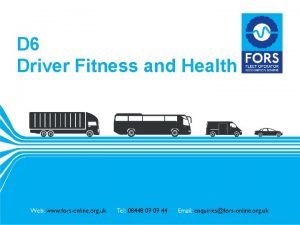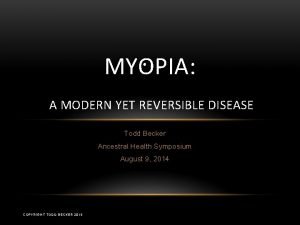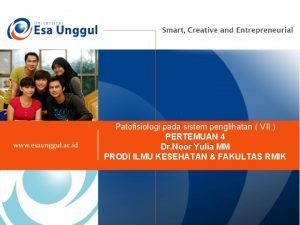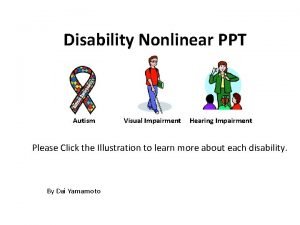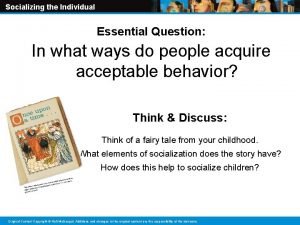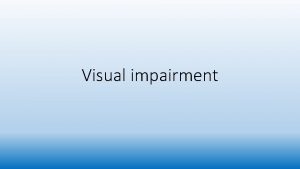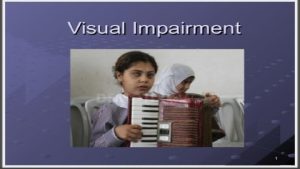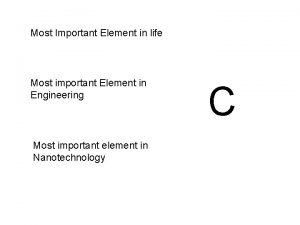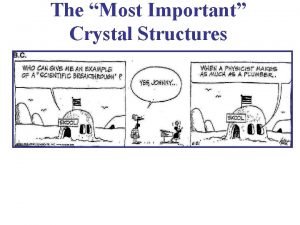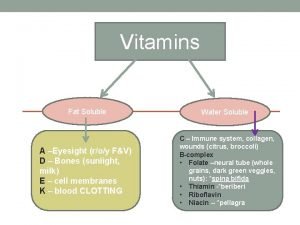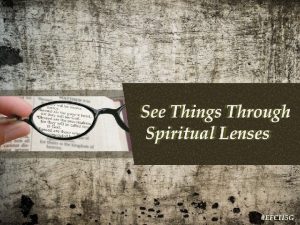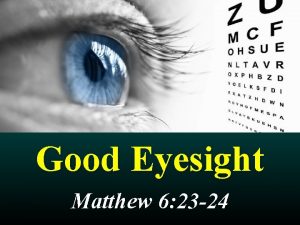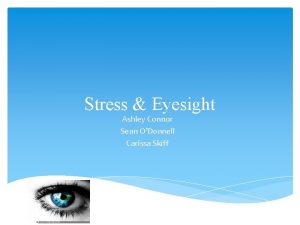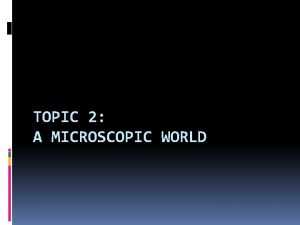Visual impairment Visual impairment Eyesight the most important












- Slides: 12

Visual impairment

Visual impairment • Eyesight = the most important sense; primary sense for 90 % of informations • Visual limitation = mainly worsened orientation, further communication, mental integrity and social existence • Visual impairment = that kind of impairment in which problems with gaining and processing of information by visual way remains even after an optimal correction(medicamments, surgery, eyeglasses) • Different levels of visual impairment

Etiology and Diagnostics • Etiology – defects in area of receptor, neural trakcs or visual centre Prenatal – inborn defects + infection of mother Postnatal – mainly defects of refraction, further glaukoma, inflammations, tumors and intoxication Often progressive defects Normal development of an eye is finished until cca 6 years of age – it is very important when the handicap occurs • Diagnostics – by a stimulus of a patient as well as by an incentive of family etc. - Screening examination of a visual sharpness (tables with optotypes a refractometers (mostly not serious handicap) - Serious handicaps are early known (+ motor and mental deviations)

Classification According to affected visual functions: - Limitation of visual sharpness - Limitation of visual field - Colour-blindness - Defects of accomodation (refraction defects) - Defects of visual adaptation - Defects of eye ability to move - Defects o 3 D vision According to a level of visual impairment - Purblindness - Residues of eyesight - Blindness According to a time of origin – inborn X gained According to etiology - Organ (defects of len or retina) - Functional (defects of binocular vision etc. )

Classification of visual impairment according to WHO 1) 2) 3) 4) 5) Middle purblindness – viz lower than 6/18, min. 6/60, visual impairment category No. 1 Strong purblindness - viz lower than 6/60, min. 3/60, visual impairment category No. 2 Deep purblindness – a) viz lower than 3/60, min. 1/60, visual impairment category No. 3 b) concentric narrowing of visual field of both eyes under 20°, or of a single eye under 45° Real blindness – maximal possible correction = 1/60, photosensitivity or visual field limitation up to 5° around central fixation, visual impairment category No. 4 Total blindness – a state from absolut loss of photosensitivity up to a maintenance of photosensitivity, but with incorrect light projection, visual impairment category No. 5 Fraction (for example 6/18) is called„viz“

Education and upbringing • Very old matter • Louis Braille (1809 – 1852) – he was blind, he created a special system of a dot system of writing =) until today probably the best systém which is widely used (http: //www. irenabrichzinova. estranky. cz/clanky/braillova-abeceda. html) • Oskar Pichte – 1897 =) Picht machine (6 keys for notation of particular points in a structure of each character =) character = a combination of keys) • Origins of educationa care in Czech republic – Hradčanský (1807) and Klárovský (1832) institute for blind people • Recent time – common school as well as special school (Ministry regulation No. 73/2005 Sb. ) – including conservatory • Very important is an intensive early care =) The society for early care – a network of early care centres (mainly in big cities) - offering of professional services and supporting of families with problems caused by some ind of handicap

Specifics of education of visual impaired people Basic precondition – succesfull compensation (wide scale of tools): - Computers and special computer techniques, optical and digital devices - Contrast markers with bold track - Suitable combination of colours, coloured films Basic principles: - Suitable light, enough of light - Suitable temperature in a room - Noise limitation - Suitable space adjustment Application of internet - Blind friendly Web pages (contrast of colours, grafic layout, text characteristics etc. , voice output, Braille row) Basic problem: limitated possibility of situational and random learning

Specifics of a life of people with visual impairment Myths and prejudices They are deprived in all range of visual perceptions They cannot percieve a diversity of a world They don´t care about their appearence etc. The same life as others Limitation in elementar and basic operations – but mostly there does exist simple and elegant solution (e. g. sound indicator in a cup of tea, sound indicator of traffic lights, relief signs - banknotes etc. ) • Problem of help offering • Issues of failing to notice X imposing • • •

Possibilities and preconditions of inclusive integrating into society • The basis is always personal experience! =) to spread knowledgesand healthy inklusive attitudes • Mostly common school (special school could be a precondition of partial segregation) • Study branches which can be applied in a job market – manual as well as mental • Tyfloservis and Tyflocentrum (original projects of united union of blind and purblind people – SONS) – complex offer of advisory, informational, social and educational services • Basic precondition – reciprocal respect and regard =) forthcoming measures

Optotypes

Refractometer

Picht machine
 Least important to most important
Least important to most important From most important to least important in writing
From most important to least important in writing From most important to least important in writing
From most important to least important in writing Youtube.com
Youtube.com Www.fors-online.org.uk
Www.fors-online.org.uk Age fatigue inattentiveness eyesight and footwear are
Age fatigue inattentiveness eyesight and footwear are Hormesis eyesight
Hormesis eyesight Patofisiologi miopia
Patofisiologi miopia Hearing impairment ppt
Hearing impairment ppt Socializing the individual review worksheet
Socializing the individual review worksheet Consist of your most important targeted or segmented groups
Consist of your most important targeted or segmented groups Rewriting an existential universal statement
Rewriting an existential universal statement Scalp care shampooing and conditioning chapter 15
Scalp care shampooing and conditioning chapter 15




